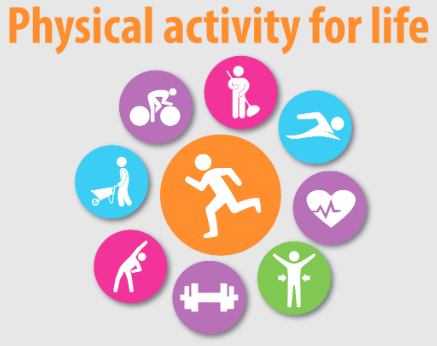There appears to be a linear relationship between physical activity and health status, such that increasing physical activity and fitness leads to further improvements in health status. One in every four adults worldwide do not meet the global recommended levels of physical activity.
World Health Organisation (WHO) defines physical activity as ‘any bodily movement produced by skeletal muscles that requires energy expenditure. Physical activity refers to all movement including during leisure time, for transport to get to and from places, or as part of a person’s work. Both moderate- and vigorous-intensity physical activity improve health.’
There are several health-related components of physical activity. They are:
- Cardiorespiratory endurance: the ability of the circulatory and respiratory system to supply oxygen during physical activity.
- Muscular strength: the ability of the muscle to exert force.
- Muscular endurance: the ability of the muscle to perform without fatigue.
- Flexibility: the range of motion present in a joint.
Physical activity can have a number of advantages, including:
- Improving sleep
- Maintaining healthy weight
- Stress Management
- Improving quality of life
(Centers of Disease Control and Prevention, Benefits of physical activity 2022)
Increasing physical activity and optimising exercise are believed to be optimal ways to improve musculoskeletal health.
What is the right amount?
WHO guidelines and recommendations outline how much physical activity is required for good health for various ages and population groups (World Health Organization, Physical activity 2022).
Children and adolescents aged 5-17 years
- should do at least an average of 60 minutes per day of moderate-to-vigorous intensity, mostly aerobic, physical activity, across the week.
- should incorporate vigorous-intensity aerobic activities, as well as those that strengthen muscle and bone, at least 3 days a week.
- should limit the amount of time spent being sedentary, particularly the amount of recreational screen time.
Adults aged 18–64 years
- should do at least 150–300 minutes of moderate-intensity aerobic physical activity;
- or at least 75–150 minutes of vigorous-intensity aerobic physical activity; or an equivalent combination of moderate- and vigorous-intensity activity throughout the week
- should also do muscle-strengthening activities at moderate or greater intensity that involve all major muscle groups on 2 or more days a week, as these provide additional health benefits.
- may increase moderate-intensity aerobic physical activity to more than 300 minutes; or do more than 150 minutes of vigorous-intensity aerobic physical activity; or an equivalent combination of moderate- and vigorous-intensity activity throughout the week for additional health benefits.
- should limit the amount of time spent being sedentary. Replacing sedentary time with physical activity of any intensity (including light intensity) provides health benefits, and
- to help reduce the detrimental effects of high levels of sedentary behaviour on health, all adults and older adults should aim to do more than the recommended levels of moderate- to vigorous-intensity physical activity
Adults aged 65 years and above
- Same as for adults; and
- as part of their weekly physical activity, older adults should do varied multicomponent physical activity that emphasizes functional balance and strength training at moderate or greater intensity, on 3 or more days a week, to enhance functional capacity and to prevent falls.
Further physical activity dosage recommendations for other populations such as pregnant/postpartum, disabled, and chronic condition populations can be found on the WHO page linked below.
Evidence says…
A recent high-quality systematic review looked into effective options for musculoskeletal pain management in primary care (Babatunde et al., 2017). It looked at how different exercise modalities influence back, neck, shoulder, knee, and multi-site pain. Based on the review, they suggest that “Current evidence shows significant positive effects in favour of exercise on pain, function, quality of life and work-related outcomes in the short and long-term for all the musculoskeletal pain presentations compared to no exercise or other control) but the evidence regarding optimal content or delivery of exercise in each case is inconclusive.”
In addition to this, a Cochrane review of aquatic exercise for hip and knee osteoarthritis found moderate-quality evidence suggesting that among those with hip and knee osteoarthritis, aquatic exercise may reduce pain and disability and improve quality of life immediately following the completion of the treatment programme (Bartels et al., 2016).
So what can you do…
- Get active for a healthy heart and mind à could involve walking, cycling, swimming, stairs, running or take up a sport
- Sit less by breaking up sitting times throughout the day
- Build strength to keep your muscles, bones and joints strong à you can achieve this by getting involved with the gym, yoga or even carrying your shopping bags to the car
- Improve balance to reduce your chance of falls à improve this by getting into dancing, tai chi or bowls
References
Babatunde, O.O. et al. (2017) “Effective treatment options for musculoskeletal pain in primary care: A systematic overview of current evidence,” PLOS ONE, 12(6). Available at: https://doi.org/10.1371/journal.pone.0178621.
Bartels, E.M. et al. (2016) “Aquatic exercise for the treatment of knee and hip osteoarthritis,” Cochrane Database of Systematic Reviews [Preprint]. Available at: https://doi.org/10.1002/14651858.cd005523.pub3.
Benefits of physical activity (2022) Centers for Disease Control and Prevention. Centers for Disease Control and Prevention. Available at: https://www.cdc.gov/physicalactivity/basics/pa-health/index.htm#:~:text=Being%20physically%20active%20can%20improve,ability%20to%20do%20everyday%20activities. (Accessed: December 6, 2022).
Physical activity (2022) World Health Organization. World Health Organization. Available at: https://www.who.int/news-room/fact-sheets/detail/physical-activity (Accessed: December 6, 2022).

